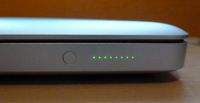Getting the Most Out of Your Battery (Mac)
The newer MacBook Pro has a built-in battery.
Using Your Battery
When the external power adapter is not connected, your computer draws power from its battery. The length of time that you can run your MacBook depends on what you are doing on your Mac. Turning off features such as wireless technology can help conserve battery charge.
You can determine the charge left in your battery by looking at the battery level indicator lights on the left side of your MacBook. Press the button next to the lights, and the lights glow briefly to show how much charge is left in the battery.
Important: If only one indicator light is on, very little charge is left. If no lights are visible, the battery is completely drained and the computer will not start up unless the power adapter is connected. Plug in the power adapter to let the battery recharge, or replace the drained battery with a fully charged battery. If your battery runs low while you are working, attach your power adapter and let the battery recharge.
Battery Icon on Menu
If the battery icon in the Finder menu bar is set to show the percentage of charge, sometimes the battery won’t show a full 100 percent charge when the power adapter is attached. This is normal behavior; battery life is maximized if charging is not continuously cycled on and off when the battery’s charge capacity is between 95 and 100 percent.
When the battery level eventually drops below 95 percent, it will charge all the way up to 100 percent. Charging a Battery When the power adapter is connected to your computer, the battery recharges whether the computer is off, on, or in sleep. However, the battery recharges more quickly if the computer is off or in sleep. When the computer is on, you can monitor the battery charge level using the Battery status icon in the menu bar.
The battery charge level displayed is based on the amount of power left in the battery with the applications, peripheral devices, and system settings (display brightness, Energy Saver settings, and so on) you are currently using. To conserve battery power, close applications and disconnect peripheral devices not in use, and adjust your Energy Saver settings (see the next section).
Battery Conservation Tips
The amount of work time your MacBook battery can provide before you need to recharge depends on the applications and peripheral devices you’re currently using and the steps you take to conserve power while you work. For the best conservation of battery power, do the following:
- Disconnect bus-powered USB or FireWire devices when they are not in use.
- Quit open applications that you are not using.
- Turn off AirPort or Bluetooth wireless when they are not in use. (Use the AirPort and Bluetooth status icons in the menu bar. If these icons don’t appear in the menu bar, you can turn them on in the Network and Bluetooth panes of System Preferences.)
- Remove CD and DVD discs when they are not in use.
- Reduce screen brightness using the brightness controls on the MacBook keyboard.
- Set the hard disk to spin down after a short time. In the Energy Saver pane of System Preferences, select the “Put the hard disk to sleep when possible” option.
- Set your MacBook to sleep after inactivity of five minutes or less.
Your MacBook is preset to automatically reduce its processing speed during periods of low processing activity when using battery power, thus reducing power usage. The setting that determines this is the Normal option in the Optimization pop-up menu of the Energy Saver pane of System Preferences.
During periods of high processing activity, your computer will automatically switch to a higher processing speed. To conserve the most battery life, choose Better Battery Life from the Optimization pop-up menu. However, choosing this option may affect your computer’s performance.
To set your computer to use its highest processing speed at all times, choose Better Performance.
Energy saving information (Mac)
Your systems pre
Calibrating Your Battery
To get the longest running time from your battery: calibrate it sometime during the first week you have your MacBook and recalibrate monthly to keep your battery functioning at its fullest capacity.
To calibrate your battery:
- Plug in the power adapter and fully charge your MacBook battery until the light on the power adapter plug changes to green and the Battery icon in the menu bar indicates that the battery is fully charged.
- Allow the battery to rest in the fully charged state for two hours or longer. You may use your computer during this time as long as the adapter is plugged in.
- Disconnect the power adapter with the MacBook on and start running it from the battery. You may use your computer during this time.
- When your battery gets low, you’ll see the low battery warning dialog on the screen.
- Continue to keep your computer turned on until it goes to sleep. Save your work and close all applications when the battery gets low and before the system goes to sleep.
- Turn off the computer or allow it to sleep for five hours or longer.
- Connect the power adapter and leave it connected until the battery is fully charged again.
- Important: Repeat the calibration process at least once per Semester to keep your battery fully functioning. If you use your MacBook infrequently, it’s best to recalibrate the battery at least once a month. If you purchased additional batteries, repeat the calibration procedure with those batteries as well.
